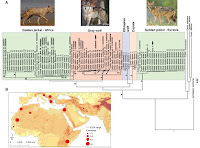African Hunting Dogs, Lycaon pictus, are highly social pack hunting Canids found across much of Sub-Saharan Africa, though they have been heavily persecuted by Humans in many areas, and now have a patchy distribution, with the highest numbers in Southern and East Africa. They are considered to be Endangered under the terms of the International Union for the Conservation of Nature's Red List of Threatened Species, due to a sharply declining population, conflict with Humans, habitat loss and susceptibility to infectious diseases carried by domestic Dogs. As such they are considered a conservation priority in many areas, making it essential to understand the behaviour and needs of the species. Unlike most other Dog species, which tend to be fairly omnivorous, African Hunting Dogs are hypercarnivores with a very high proportion of meat in their diet. Their hunting strategy has been extensively studied on the Grassland Plains of East Africa, where the Dogs engage in extended pursuits of prey involving multiple individuals targeting a single prey animal and running it down over long distances. However the majority of African Hunting Dogs are known to live in Woodland or Mixed Woodland and Savannah environments, where such highly co-ordinated long distance hunting would be an implausible strategy, suggesting that other hunting methods are in use.
In a paper published in the journal Nature Communications on 29 March 2016, Tatjana Hubel of the Structure and Motion Laboratory at the Royal Veterinary College, Julia Myatt of the Structure and Motion Laboratory at the Royal Veterinary College and of the School of Biosciences at the University of Birmingham, Neil Jordan of the Botswana Predator Conservation Trust, the Centre for Ecosystem Science at the University of New South Wales and the Applied Eco-Logic Group at Taronga Western Plains Zoo, Oliver Dewhirst, also of the Structure and Motion Laboratory at the Royal Veterinary College, Weldon McNutt also of the Botswana Predator Conservation Trust and Alan Wilson, again of the Structure and Motion Laboratory at the Royal Veterinary College, discuss the results of a study of hunting methods employed by a pack of African Hunting Dogs in a woodland environment in northern Botswana.
Hubel et al attached collars with GPS units to all six adult members of the pack (a dominant pair plus two male and two female sub-dominant adults, all of which were siblings of one or other of the dominant pair) in order to track them during hunting forays in a woodland environment where direct observation was difficult (only a single hunt was observed directly). Around 80% of the prey taken by the pack was Impala, an Antelope species large enough to satisfy the feeding needs of the entire pack without competition.
African Hunting Dog with colar. Hubel et al. (2016).
Hubel et al. found that unlike the East African Hunting Dogs the Botswanan Dogs did not engage in long distance hunting, rather the group moved through the woodland in a spear formation seeking prey, which once located was chased down in a short pursuit by one or more Dogs. Pursuit lasted only a few hundred meters, after which the chase was broken off if unsuccessful. Around 15% of such pursuits resulted in a kill.
When moving in search of prey the pack was typically led by one of the sub-dominant males, Scorpion, though he often did not take part in the pursuit of prey. Neither did the dominant male, Kobe, nor the dominant female, Timbuktu, frequently take part in pursuits, though they were the first to feed at kills (this is typical for dominant African Hunting Dogs, particularly the females which are often pregnant). The Dog at the rear of the pack when searching for prey was a sub-dominant female, Kigali, who had previously sustained a leg injury and walked with a limp, however she was a frequent participant in chases after prey, and appeared to be successful in this role (success of a hunt was determined by the members of the pack converging on the prey to feed, detected by GPS system, rather than direct observation of the kill).
See also...
 Cryptic diversity: A new species of Wolf from Africa. Cryptic species are species which
closely resemble other species and which can only be separated by careful
anatomical examination or even genetic analysis. In recent years the widespread
application...
Cryptic diversity: A new species of Wolf from Africa. Cryptic species are species which
closely resemble other species and which can only be separated by careful
anatomical examination or even genetic analysis. In recent years the widespread
application... Using morphometric analysis to understand the nature of Canid remains from Plio-Pleistocene Hominid sites from East Africa.
Morphometric analysis is a method used...
Using morphometric analysis to understand the nature of Canid remains from Plio-Pleistocene Hominid sites from East Africa.
Morphometric analysis is a method used...
Foxes (Vulpini) are a subgroup of the Dog Family, Canidae, found in
North America, Eurasia and Africa (South American Foxes are a separate
group, more closely related to True Dogs than to other Foxes). The...
Follow Sciency Thoughts on Facebook.


